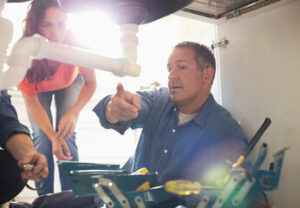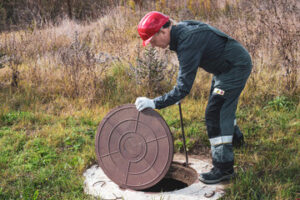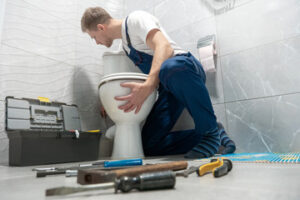Plumbing is a vital part of any home. It delivers fresh water and safely removes wastewater. Plumbers are responsible for installing, maintaining and repairing these systems. They must also understand how to read blueprints and building codes. Contact Plumber Sarasota for professional help.

Faucets are mechanical devices that use a screw to reduce the force needed to hold back water molecules. This principle is called mechanical advantage.
The drainage system requires water to move, but it also needs air to equalize pressure and help with the transport of sewage. The vent system provides this movement. Without it, you could experience a variety of problems that are difficult and dangerous to resolve. A venting problem can result in a number of issues including wastewater backups, dangerous fumes, and recurring gurgling in the pipes. In order to ensure that your plumbing venting is working properly, you should consider hiring a professional plumber to perform a vent check and maintenance.
The plumbing venting system includes a series of pipes that connect the drainage systems of your toilets, sinks, and showers to the outside sewer or septic line. It carries the waste to the septic or city sewer lines and keeps the water from leaking into your home. It is important to make sure that your venting system is set up according to the building code and that you have enough pipes to reach the septic or city sewer lines.
Typically, the venting system is built of PVC, ABS, or copper and should be designed to be resistant to corrosion and abrasion. The piping should be sized correctly to match the plumbing fixtures it is connecting. It is also recommended that you have your venting system tested and inspected on a regular basis to prevent leaks.
When it comes to the type of vent you choose, there are two common options: a wet vent or dry vent. A wet vent combines the functions of a drain and vent into one pipe, making it perfect for systems with limited space. It can also help to streamline the piping, reducing costs and complexity.
A dry vent, on the other hand, is a specialized venting system that doesn’t carry any water. It can help to eliminate odors by directing toxic sewer gases away from the building’s occupants. It is also important to remember that the height of the vent stack should be tall enough to avoid re-entry of sewer gasses into your residence. Vents should also be kept free of obstructions, such as birds’ nests, leaves, and dirt.
Fixtures
Plumbing fixtures are essential components that interact with your home’s water supply and waste removal systems. They include sinks, faucets, toilets, and showerheads. They help control the flow of clean water in your North Texas home, allowing you to perform everyday tasks like washing dishes and taking a relaxing shower. They also serve as important design elements in your kitchen and bathrooms.
Plumbing fixture styles range from minimalist modern to ornate traditional designs. They can make a significant impact on the appearance of your home’s interior, making it important to choose one that aligns with your preferred aesthetic. You can also coordinate your plumbing fixtures with other kitchen and bathroom design features to create a polished, cohesive look throughout your home.
When choosing a new plumbing fixture, it’s crucial to consider its size compatibility and fit with your existing system. This will ensure that your new fixture is installed properly and avoids any potential problems down the road. It’s also important to consider the cleaning and maintenance requirements of your chosen fixture. For example, some materials and finishes are more susceptible to water spots and corrosion than others. Opting for a more durable, low-maintenance fixture will save you time and money in the long run.
Whether you’re looking for a simple, functional upgrade or a complete remodel of your bathroom and kitchen, it’s crucial to consult with a professional. They can offer expert advice and recommendations based on your unique needs and preferences. They can even help you find the right fixtures to suit your budget and lifestyle.
While many homeowners prioritize functionality and durability over aesthetics when selecting plumbing fixtures, it’s possible to strike a balance between quality and style. By doing your research and consulting with a design expert, you can find fixtures that meet both your quality and aesthetic requirements.
Plumbing and piping
The plumbing and piping systems are essential components of any home. They deliver fresh water and remove wastewater, and they must be properly maintained to prevent costly repairs. Plumbing professionals work in a wide variety of settings, from small offices to large industrial facilities. They may specialize in particular types of plumbing installations and equipment. They also need to have knowledge of building codes, safety regulations, and engineering design.
Plumbing systems are complex, and they often require extensive pipework. They are regulated by local, state, and federal rules. Many plumbers spend their careers repairing and maintaining pipes, but others focus on the installation of new plumbing fixtures or systems. Some plumbers even work on fire sprinklers and industrial plumbing equipment.
A plumbing system starts with a water supply line that brings water from a water meter to a house. From there, it moves through the pipes to all of the water outlets in a house, such as sinks, bathtubs, showers, dishwashers, clothes dryers, and toilets. It also includes drain lines that carry waste water to the sewer system or septic tank.
Most people are familiar with the plumbing system in their own homes. They have a basic understanding of how the system works and what can go wrong with it. However, they may not know that there are other plumbing systems in larger buildings and industrial facilities. These systems are more complicated, and they use different materials than residential plumbing. They also have different safety requirements and follow different rules and regulations.
Piping, also known as piping design, is the detailed specification of the physical piping layout within a commercial or industrial facility. It was previously called drafting, technical drawing, and engineering drawing, but today it’s often performed by software-based computer programs.
Plumbers working on a construction project must ensure that all design details are accurate and comply with industry codes and standards. This includes coordinating and interfacing with discipline lead engineers to review vendor drawings and data. It’s also important for them to understand the different processes that take place during fabrication and assembly.
Maintenance
Plumbing is your house’s circulatory system, running unseen behind the walls and under the floorboards, carrying water to and from fixtures like sinks, toilets, showers, and water heaters. It’s crucial for modern living, but proper maintenance and occasional repairs are needed to keep it functioning correctly. Taking some time to understand how plumbing works can help you spot problems before they become major headaches.
Some of the most common plumbing issues include clogged drains, leaky faucets, and running toilets. These problems can be caused by a number of factors, such as mineral deposits, faulty parts, or temperature fluctuations. By understanding the causes of these problems, you can take preventive measures or schedule an appointment with a plumber.
Leaking faucets are often the result of worn-out washers or O-rings. Replacing these parts can fix the problem and save you money on your energy bill. Other common issues include slow drains, rusty pipes, and low water pressure. These problems can be caused by a variety of factors, including high water usage, tree roots, or even a malfunctioning pressure regulator.
Plumbers perform a wide range of tasks, from installing new pipes and fixtures to repairing leaks and clogs. They also inspect and maintain existing plumbing systems, using specialized tools to identify and repair problems. In addition, plumbers provide customer service and may collaborate with other professionals to ensure that building projects meet regulations and standards.
Plumbing is a vital part of our daily lives, but it’s easy to take for granted until something goes wrong. Then, we scramble to find a plumber and hope that the damage doesn’t worsen. By following these tips, you can reduce the risk of plumbing emergencies and keep your home in good condition. And if you do encounter a problem, remember that a professional plumber is just a phone call away!

